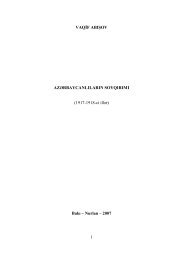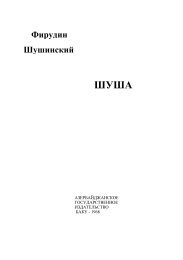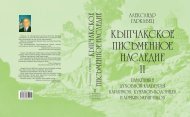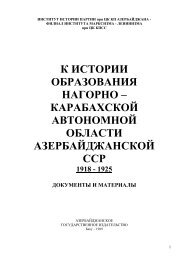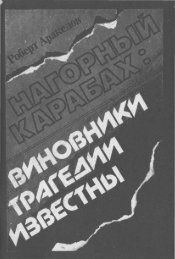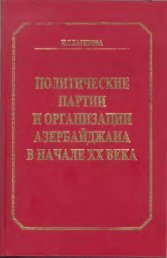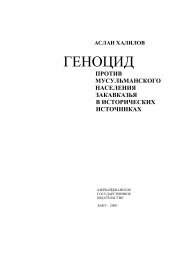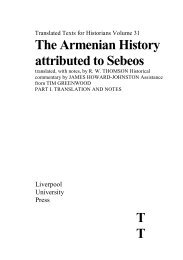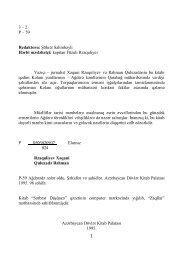ARMENIAN - Erevangala500
ARMENIAN - Erevangala500
ARMENIAN - Erevangala500
You also want an ePaper? Increase the reach of your titles
YUMPU automatically turns print PDFs into web optimized ePapers that Google loves.
horrifying reality when he started a large-scale relocation<br />
of the Armenians to - o f all places - the Altai region, the<br />
original homeland o f the Turks.<br />
There is one thing that is usually overlooked in connection<br />
with the Armenian tragedy - Article 31 o f the Treaty<br />
of Lausanne. It contains the stipulation that every> former<br />
citizen o f the Ottoman Empire who had acquired a new<br />
nationality through the establishment o f the new independent<br />
states could come to Turkey as a Turkish citizen<br />
anytime within two years. Article 31 naturally applied to<br />
all the Ottoman-Armenian citizens who had been relocated<br />
during the war, or who - for whatever reason - did not<br />
happen to be on Turkish soil after the war. Article 31 was<br />
tailor-made for the Armenians who had been relocated<br />
and now wanted to move back to Turkey. In accordance<br />
with this clause, every Armenian who had once been an<br />
Ottoman citizen had until July 24, 1925 to come to<br />
Turkey as a Turkish citizen with the same rights as every<br />
other Turkish citizen.<br />
All talk o f "expulsion" is thus unfounded, especially in<br />
light o f the fact that the Armenians had never even been<br />
moved out o f the Ottoman Empire after the uprisings in<br />
eastern Anatolia; they had simply been moved to less<br />
threatened provinces within the Empire.<br />
“ Finally, Peace with Turkey”<br />
Reads the caption under the “leading personalities” at the<br />
peace conference o f Lausanne. The treaty between the<br />
powers o f the Entente, Greece and Turkey was ratified in<br />
Lausanne on July 24, 1923. The delegates (beginning with<br />
the third one on the right): Alexander Stamboliyski<br />
(Bulgaria), General Pelle (France), Ismet Pasha (Inonii,<br />
Turkey), the hostile Swiss Federal President Scheurer, Sir<br />
Horace Rumbold (Great Britain), M. Diamandy<br />
(Romania), the M archese di Garriona (Italy) and<br />
Ambassador Ochiai (Japan). On the far left, the delegates<br />
o f the “Kingdom of the Serbs, Croats and Slovenes”, who<br />
did not sign. The Turkish delegation had brought about an<br />
unprecedented favourable conclusion to the treaty thanks<br />
to the prudent, skillful and self-confident leadership of<br />
Ismet Pasha. This result might first o f all be attributed to<br />
the fact that his manner rendered him es a not inferior, but<br />
a party with equal rights.<br />
While contemporary commentators praised them as “The Great<br />
Three” o f the Peace Conference o f Lausanne, with the hindsight<br />
afforded by history they appear rather miserable: Lord Curzon, a<br />
self satisfied, unreasonable and violent diplomat who infested<br />
Central Europe, just as he had earlier done in India in his capacity<br />
as viceroy o f India; Benito Mussolini, at that time already<br />
prime minister o f Italy, and M. Poincare, the notorious warmonger<br />
and occupier o f Rhineland (January 1923), indirectly one o f<br />
the persons primarily to blame for the rise o f the National<br />
Socialistsin Germany.<br />
123



